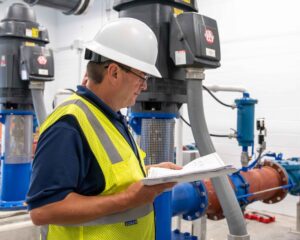
By LEO CANNYN, PMP, PE, ENV SP
Principal Project Manager,
Beryl Engineering & Inspection
Moving Forward Means Reviewing the Needs of Higher Education, Capitalizing on New Technology, and Utilizing Innovative Materials
Structural engineers are problem solvers. Routinely faced with new and challenging situations, they think out of the box and find creative solutions. Additionally, they work in high-pressure situations and are the ones who make sure structures are safe, even in the face of extreme conditions.
Future of Structural Engineering
However, structural engineers are looking at new challenges. This includes how to successfully grow the profession, so the next generation of engineers thrive for the duration of their careers and for those that follow.
To move forward, the industry must be prepared to navigate these modern-day changes, including technological advancements, increased complexity in building codes and standards, demand for education, and the environmental impact on building structures.
These, and many other transformations in the industry, are already challenging how day-to-day business is conducted. Change is good; however, change cannot always be controlled, but as a profession, it is important to respond, persevere through the obstacles, and look at them as opportunities for growth.
Advancements to Meet the Demands of the Engineering Profession
A Single Source of Truth for Rapid Decision-Making
Combining Model-Based Deliverables (MBD) and AI creates exciting new opportunities for structural engineers. MBD is a concept that uses digital models to communicate design intent and information throughout the project. It can be used as a single source to communicate with all stakeholders, improving communication. Combined with AI, tasks can be automated which significantly improves efficiency.
Innovative New Materials
New materials allow structural engineers to incorporate innovation, sustainability, and improved performance into their designs. These materials include synthetics, fibers, composites, polymers, and natural materials. When using the latest advancements in materials science and construction technology, structural engineers can ensure they utilize the most effective and efficient materials for their projects.
A Focus on Sustainability
Sustainable or green materials have become more affordable and, therefore, can be accessed more readily. Top environmentally-friendly building materials include bamboo, recycled steel, and sheep’s wool. Additionally, bendable concrete, also known as Engineered Cementitious Composite is stronger and more effective at absorbing shock. Mass timber, created by mechanically bonding various types of softwood, has also gained popularity due to its lower carbon footprint, significantly reducing emissions.
Safety Considerations
Safety is the control of recognized hazards to achieve an acceptable level of risk. Reducing uncertainties associated with a building is always a significant challenge. This focus saves lives, but it’s insufficient to make communities resilient to earthquakes, tornadoes, and hurricanes. Structural engineers must focus on design elements beyond the primary structural system. For example, enhanced drainage systems to manage heavy rainfall during hurricanes or building designs that preserve and protect coastal wetlands and dunes to absorb storm surges.
Tools to Collaborate and Streamline Processes
Structural engineering is seeing significant changes in the fields of information technology, computational methods, and visualization. One key enabler of this digital transformation is Building Information Modeling (BIM). Utilized as a collaborative and integrated process, BIM streamlines and improves each phase of construction and management. Additionally, BIM can create models of natural and existing environments to capture real-world data and provide context for how the structure will exist in its natural surroundings. These advancements and other digital tools have transformed the industry, improving productivity and project outcomes.
Investment in Employees
New management systems that assist with performance metrics can store customer information on different services and projects provided. However, structural engineers must adapt and learn how to utilize the technology to be useful. These systems can improve efficiency throughout the company, but creating time for training and encouraging employees to input necessary data can lead to additional work and resistance to change.
Higher Education and Curriculum Enrichment
Syncing today’s students who learn current and innovative skills with a work environment that welcomes change and advancements can be challenging. Equally, educators might not be up-to-date on engineering advancements to support the opportunities in the field. To sync the two paths and provide a more productive curriculum, universities need to ensure structural engineers actively participate in their curriculums, whether through seminars or helping in the hiring process. This collaboration helps both the student and the engineering firm by ensuring professors have current credentials with today’s structural practices.
We truly live in a digital world where the pace of change is increasing, and the need to adapt and embrace this change can be daunting. Advancements will help shape the future of structural engineering, making it a more innovative and sustainable field.
As the world becomes more challenging and complex, structural engineers will play an increasingly important role in the designing and building of safe, resilient, and sustainable structures, and we need to be ready. ●





















